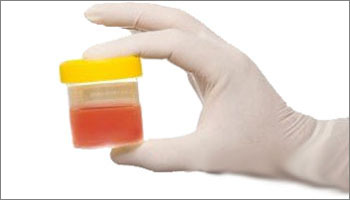
What could cause a small amount of blood to show up in urine?
Blood in the urine – haematuria – can be alarming. Although some causes of haematuria can be serious, others are fairly harmless and may clear up with little or no treatment.

Either way, it definitely should be evaluated by a healthcare provider.
Blood in the urine that’s clearly visible is called gross haematuria.
Blood in the urine that isn’t clearly visible is called microscopic haematuria.
With gross haematuria, urine may be red or pink, or similar in colour to cola, tea or rust.
Gross haematuria often occurs without other symptoms.
It takes little blood to discolour urine, so you’re probably not losing as much blood as it may appear.
However, heavier bleeding that involves passing blood clots is an urgent issue that can be painful, and puts you at risk of having a blocked bladder outlet and inability to pass urine.
What you should do
The first step is to determine if the discolouration is blood. Urine can become discoloured in other ways, such as by blood proteins (haemoglobin or myoglobin); from eating beets; or taking certain medications, including some used to treat urinary tract infections.
Occasionally, vaginal bleeding can be mistaken for haematuria and vice versa.
Haematuria in older adults nearly always indicates the need for an evaluation to determine the cause of bleeding.
To determine what is causing the haematuria, your healthcare provider may first order a urine test to determine if bleeding is caused by a urinary tract or kidney infection.
The symptoms
Symptoms of an infection may include a frequent urge to urinate, burning with urination, and abdominal pain or pressure.
More severe symptoms, such as a fever, chills, and back or side pain, may indicate a kidney infection.
Even if you don’t have symptoms, urine tests are almost always performed to check for an infection.
Urine tests and tests on the blood in the urine can often indicate if bleeding is coming from within the kidneys, which could indicate kidney disease or kidney cysts.
A family or personal health history that includes a kidney disease or urinary stones can provide important clues.
Risk of cancer
The risk of haematuria being an indicator of cancer somewhere in the urinary tract increases after age 40.
And in most cases, it’s the first symptom.
If suspected, testing for cancer may include looking for kidney, bladder, prostate or other potential cancers.
According to this contact form, a history of smoking, working with chemicals or dyes, radiation to the pelvic area and other factors heighten the risk of urinary tract cancer.
In addition to infection, kidney disease and cancer as possible causes of haematuria, there’s a long list of other possibilities, with some being more common than others.
Possible causes that are temporary and generally not worrisome, or are easily addressed, include strenuous exercise (particularly running), a blow to the kidney area, or various medications, such as the cancer drug cyclophosphamide or anticlotting drugs ranging from aspirin to warfarin to clopidogrel.
Other causes
Other possible causes may include an enlarged prostate, kidney or bladder stones, or a number of inherited kidney diseases, such as polycystic kidney disease or Alport syndrome.
It’s fairly common for no cause of haematuria to be found. For older adults with haematuria of undetermined cause, follow-up testing usually is recommended.
One goal is to determine if the haematuria was temporary, persistent or intermittent.
Another goal may be to remain watchful – or take an additional diagnostic look – for cancer or another disease that wasn’t previously detected. – Mayo Clinic News ibune News Service

Leave a Reply